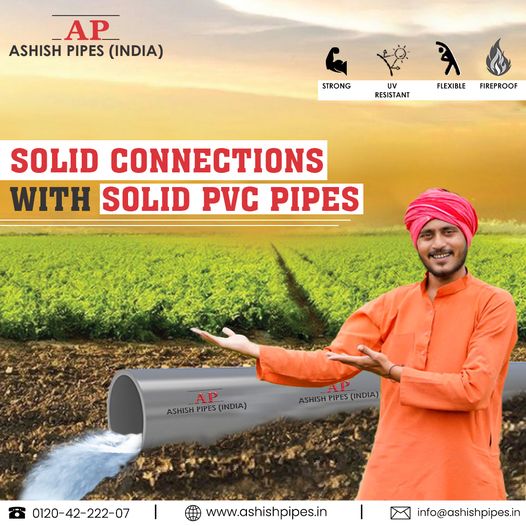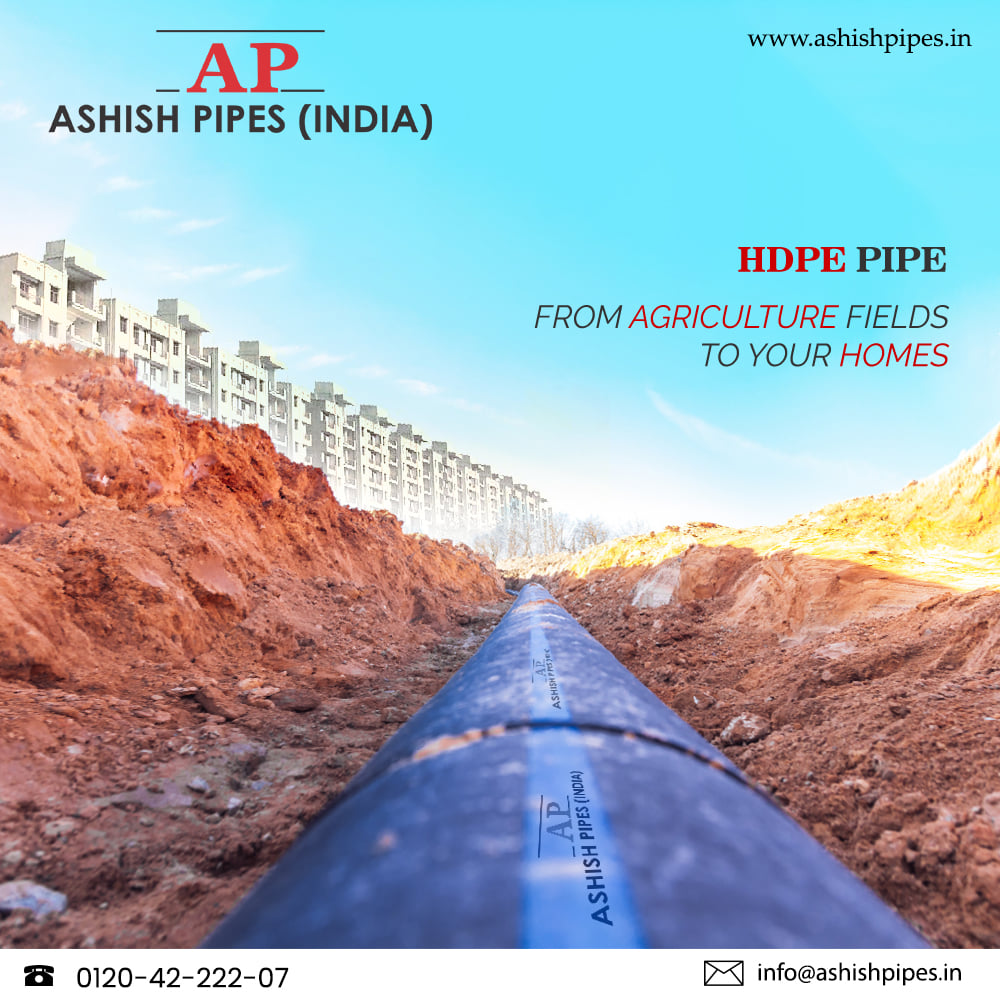
1: HDPE Coils
High-density polyethylene pipes, or HDPE pipes, are plastic pipes used to transport fluids or gases. It replaces aging concrete or steel main pipelines. The coil pipe is made from a thermoplastic with a high level of impermeability and a strong molecular bond that make it suitable for high-pressure pipelines. Ashish Pipes is a leading HDPE Coils Manufacturers in Noida, India.
Advantages of HDPE Coils:
- Corrosion resistance. Corrosion is the leading enemy of metal pipes and fittings
- Abrasion and chemical resistance
- Fatigue resistance
- Leak-proof joints
- Flow efficiency
- Ease in installation
- Longevity
- Sustainability and eco-friendliness
Disadvantages of HDPE Pipe:
- High thermal expansion.
- Poor weathering resistance.
- Subject to stress cracking.
- Difficult to bond.
- Flammable.
- Poor temperature capability.
- Low strength/stiffness.
2. Rigid Polyvinyl Chloride (PVC-U) Pipe
Sanitary polyvinyl chloride (PVC) resin serves as the primary raw material for PVC-U pipe manufacturing. Stabilizers, oils, fillers, colorants, and other chemicals are added before they are produced by a plastic extruder and injected by an injection molding machine. After cooling, shaping, inspection, packaging, and other procedures are carried out to finish producing the pipes and fittings.
Advantages of PVC-U Pipelines:
- Lightweight
- Corrosion resistance
- Low water flow resistance
- Energy saving
- Quick installation
- Low cost
Scope of Application:
- Urban tap water and water supply projects
- Water supply projects inside and outside buildings
- Industrial and mining enterprise water supply projects
- Buried fire water supply projects
- Farmland water conservancy water supply and irrigation projects
- Gardens and landscaping water supply projects
- Aquaculture water supply and drainage projects
3. Random Copolymer Polypropylene (PP-R) Water Supply Pipe
Three-type polypropylene pipe, popularly known as PP-R pipe, is created by removing random polymer polypropylene and injection molding it into pipe fittings. Early in the 1990s, a new kind of plastic pipe product was created and used in Europe. To create a new generation of pipeline materials in the late 1980s, PP-R used a gas-phase crosslinking process to manufacture some 5% of PE randomly and uniformly polymerized in the molecular chain of PP. It performs well over the long term and has strong impact strength.
Advantages of PPR Pipe:
- Moderate price
- Stable performance
- Heat insulation
- Corrosion resistance
- Smooth inner wall
- No scaling
- Safe and reliable piping system
- Impermeable
- The service life can reach 50 years
- It is said to never scale, never rust, never leak, and green high-grade water supply material.
Disadvantages of PPR Pipe:
High construction technology requirements, special tools, and professionals are required for construction to ensure the safety of the system.
PPR Pipe Application:
- The cold and hot water system of the building, including the central heating system;
- The heating system in the building, including the floor, wall panels, and radiant heating system;
- Pure water supply system that can be directly drinkable;
- Central (centralized) air conditioning system;
- Industrial piping systems for transporting or discharging chemical media.
4. Aluminum-plastic Composite Water Supply Pipe
The cast iron pipe has been replaced by aluminum-plastic composite pipes for the water supply for the first time. Its basic structure should consist of five layers, namely plastic, hot melt adhesive, aluminum alloy, plastic, and hot melt adhesive, from the inside to the outside.
The aluminum-plastic composite pipe performs well in terms of thermal insulation. Rust does not easily happen to the inner or outer walls. The inner wall is smooth, which reduces fluid resistance. Additionally, it is easy to install and build because it can be bent in any direction.
There are mainly three types of aluminum-plastic water supply pipes on the market:
- Type 1: PE/AL/PE(Polyethylene/Aluminum/Polyethylene);
- Type 2: PE/AL/PEX(Polyethylene/Aluminum/Crosslinked Polyethylene);
- Type 3: PEX/AL/PEX(Crosslinked Polyethylene/Aluminum/Crosslinked Polyethylene).
In type 1, both the inner and outer layers are made of polyethylene, in type 2, the inner layer is cross-linked polyethylene, and in type 3, the middle layer is made of both aluminum, and the inner and outer layers are both made of cross-linked polyethylene. The other two are typically used for hot water pipes, whereas type 1 is typically used for cold water piping systems.
5. Copper Tube
A copper tube is a kind of non-ferrous metal pipe, which is a pressed and drawn seamless pipe.
Advantages:
- The copper pipe has a hard texture
- Easy to corrode
- High-temperature resistance
- High-pressure resistance
- It is the best water supply pipe.
- Disadvantages: High price.
6. Thin-walled Stainless Steel Pipe
Pipes created by automatic argon arc welding and other fusion welding technologies have a wall thickness of 0.6 to 2.0 mm and are manufactured of stainless steel strips or stainless steel plates.
A brand-new form of pipe that was introduced in China in the late 1990s is the thin-walled stainless steel water pipe. The current development momentum of stainless steel water pipes is strong due to their safety and health, high strength, good corrosion resistance, sturdiness and durability, long life, maintenance-free nature, beauty, etc. It has been widely used in direct drinking water pipelines as well as construction water supplies.
Outstanding Advantages of Light Gauge Stainless Pipes:
- Excellent mechanical properties
- Superior abrasion resistance
- Good safety and sanitation
- Good temperature resistance
- Good heat preservation performance
- The smooth inner wall and low water resistance
- The appearance is beautiful, clean, stylish, 100% recyclable
- Conducive to saving water resources
- Wide range of use
- Long service life and low overall cost



























